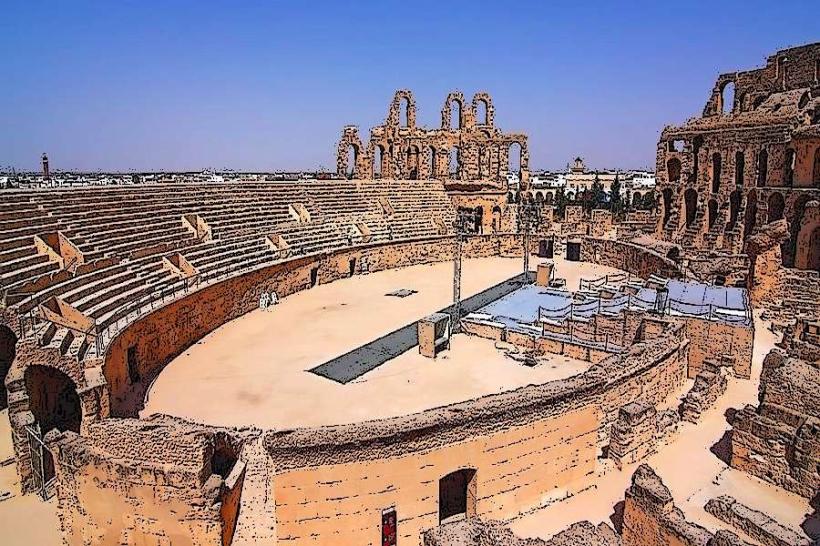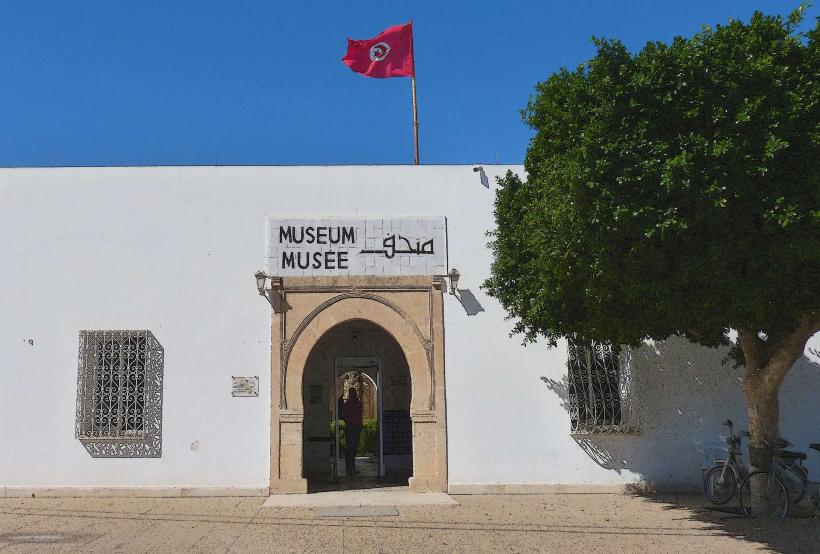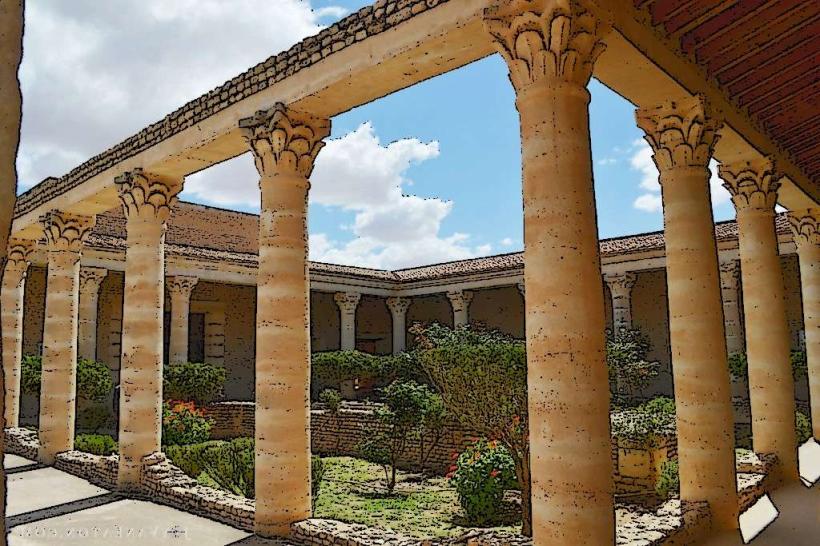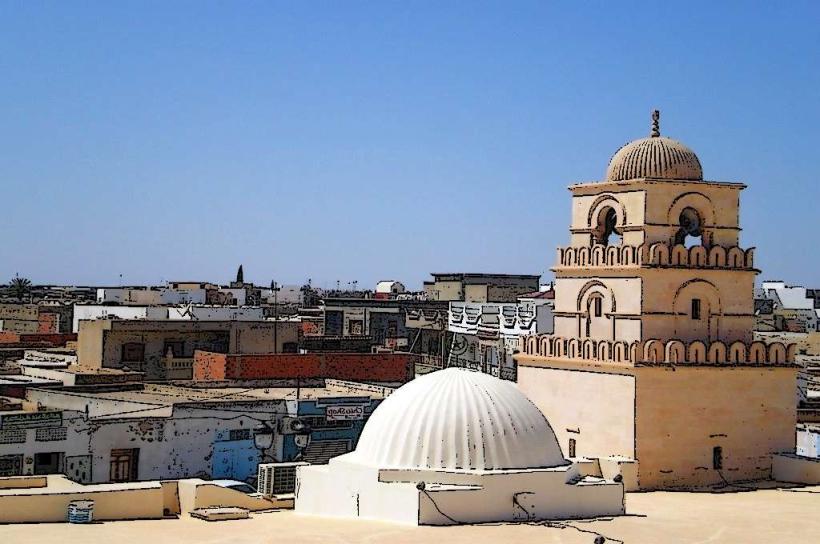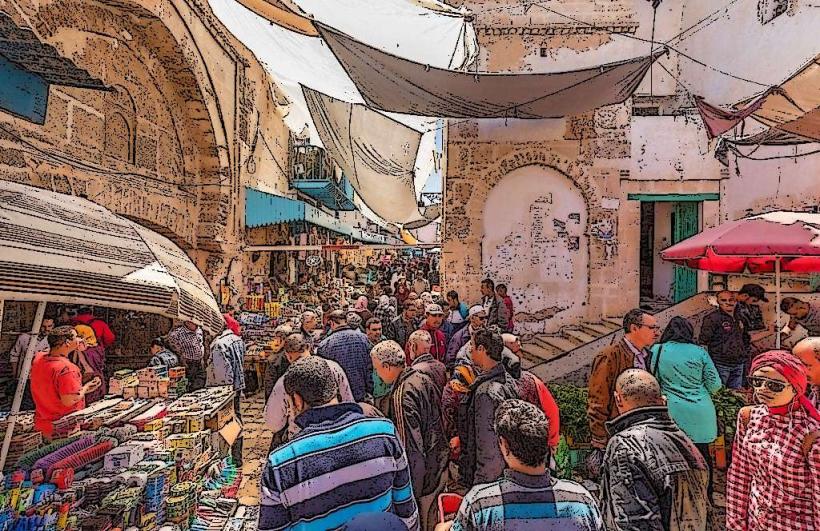Information
City: El DjemCountry: Tunisia
Continent: Africa
El Djem, Tunisia, Africa
Overview
El Djem, sometimes spelled El Jem, is a modest town in east-central Tunisia’s Mahdia Governorate, known for its rich history and sun-baked streets, and home to just 20,000 people, the town plays a pivotal role in North African history, thanks to its Roman past-most famously as the site of one of the world’s largest amphitheaters, where stone arches still catch the late-afternoon sun.Today, the town carries the quiet rhythms of rural Tunisian life, yet its narrow streets still echo with the stonework and arches of classical antiquity, consequently long ago, El Djem was called Thysdrus, a thriving hub in the Roman province of Africa Proconsularis, where sunlit stone streets echoed with the sound of merchants at work.It thrived thanks to its inland position and the rich plains around it, where groves of silvery olive trees stretched for miles.2nd–3rd Century Peak: The town thrived in the 2nd and 3rd centuries CE, its markets buzzing with the smell of fresh bread and spices, furthermore back then, Thysdrus stood toe-to-toe with Carthage in wealth and trade, its markets buzzing with the scent of fresh olives and spices, under certain circumstances Around 238 CE, workers raised the amphitheater’s stone arches, a sign the city had reached its height, not only that the city began to fade in the later days of the Roman Empire, its streets growing quieter after the Vandal and then Byzantine invasions.When the Arabs swept through, they left part of the amphitheater in ruins and turned its stone arches into a fortress, then over the centuries, the amphitheater became a fortress, a protected haven, and later a source of stone that locals chipped away for their own buildings.Interestingly, El Djem sits on the inland Sahel plain, about 60 kilometers south of Sousse and nearly 200 kilometers below Tunis, where the land stretches wide and flat under the sun, as well as the area sits in the middle of wide, open farmland, with rows of silvery-green olive trees stretching toward the horizon.The land is semi-arid, baking under a sweltering, dry sun that cracks the soil, what’s more the town’s compact, with streets curling around a weathered stone amphitheater at its heart.The streets form a neat grid, lined with low-rise buildings, their windows catching the late afternoon light, at the same time most houses are just one or two stories, each with a quiet courtyard shaded by a minute tree.The town’s dotted with minute shops, a couple of schools, the post office, municipal buildings, and sunlit public squares where kids chase pigeons, what’s more in El Djem, the economy revolves around olive farming, with rows of silvery-green trees stretching toward the horizon.Since Roman times, the region has thrived on olive oil production, its presses once echoing through sun‑baked hills, not only that tourists come to the town in every season to behold the amphitheater, filling cafés, buying trinkets from market stalls, and booking guided tours that keep money flowing into the community.Local artisans weave vivid textiles and shape cool, earthy clay into traditional ceramics, to boot local shops serve both the folks who live here and the visitors wandering in for a cup of coffee or a keepsake.Industry here is sparse, with most folks working the fields, running compact shops, or guiding visitors through the antique stone streets, after that in El Djem, life moves at a gentle pace, with the soft clink of cups in a modest café and neighbors greeting each other under the warm afternoon sun.Social life mostly centers on the family, the mosque, the market, and the lively chatter of cafés, after that the local food is straightforward and tied to the seasons, with couscous, hearty vegetable stews, tender lamb, and dishes rich with the taste of fresh olives.You’ll often find traditional bread baking alongside local pastries, warm from the oven and rich with the smell of butter, in turn each week, the market draws locals and visitors from nearby villages, offering fresh tomatoes, colorful scarves, fragrant spices, and everyday household items.Most people here are Muslim, and their faith weaves through everyday routines, from the call to prayer at dawn to lively festival gatherings, not only that people comprehend the town for its warm welcome and tight-knit spirit, where a neighbor might wave to you from a porch swing.El Djem sits on regional roads that link it to Sfax, Sousse, and Mahdia, with sun-baked asphalt stretching out in every direction, on top of that rail: The town’s station connects directly to the national rail network, where you can hear the sharp whistle as trains pull in.Local transport’s easy to find-taxis glide through busy streets, and shared minibuses called louages rumble between neighborhoods, to boot education and health in the town come through its public schools, a couple of vocational institutes, and a regional hospital where patients might hear the steady hum of timeworn medical equipment while receiving basic care.Utilities and services include essentials like running water, electricity, and phone lines, though in some rural spots the lights might flicker or the tap may run dry now and then, and el Djem has a semi-arid climate, with summers that often climb past 35°C (95°F) under a blazing sun, and winters that stay mild and gentle.Rain falls rarely, mostly between November and March, often arriving in brief, silvery bursts, alternatively traditional farmers have learned to work with the dry climate, using stone cisterns to store precious rainwater and planting hardy crops such as olives and barley.Traditional homes in architecture and urban design often use adobe or stone, with shaded courtyards at their center to keep the summer heat at bay, furthermore modern additions have crept in-a few concrete buildings, a stretch of smooth pavement-but the town’s growth still feels tiny and unhurried.Modern life moves around the preserved Roman ruins, with the amphitheater looming over the city like a stone giant, also in Thysdrus, people carry a deep pride in their ancient Roman roots, as if the antique stone arches still whisper their story.The amphitheater stands as a cultural landmark, linking the town to the sweep of Mediterranean history, its worn stone steps still warm under the afternoon sun, besides el Djem comes alive with events like the International Festival of Symphonic Music, where orchestras perform under the stone arches of its ancient amphitheater, attracting crowds from across Tunisia and beyond.Local Pride: Though it’s just a modest town, El Djem carries a proud identity, shaped by its ancient ruins and the quiet hum of life in the surrounding fields, what’s more in El Djem, ancient stone arches rise over dusty streets, where the past meets the rhythms of everyday Tunisian village life, in a sense Compact and still growing, it commands a respected spot in North Africa’s cultural and historical tapestry, like a luminous tile in an ancient mosaic, then life here drifts at a gentle pace, rooted in community, farming, and tradition, with the towering Roman amphitheater standing like a stone sentinel that’s shaped the town’s identity for thousands of years.
Author: Tourist Landmarks
Date: 2025-10-29
Landmarks in el-djem

